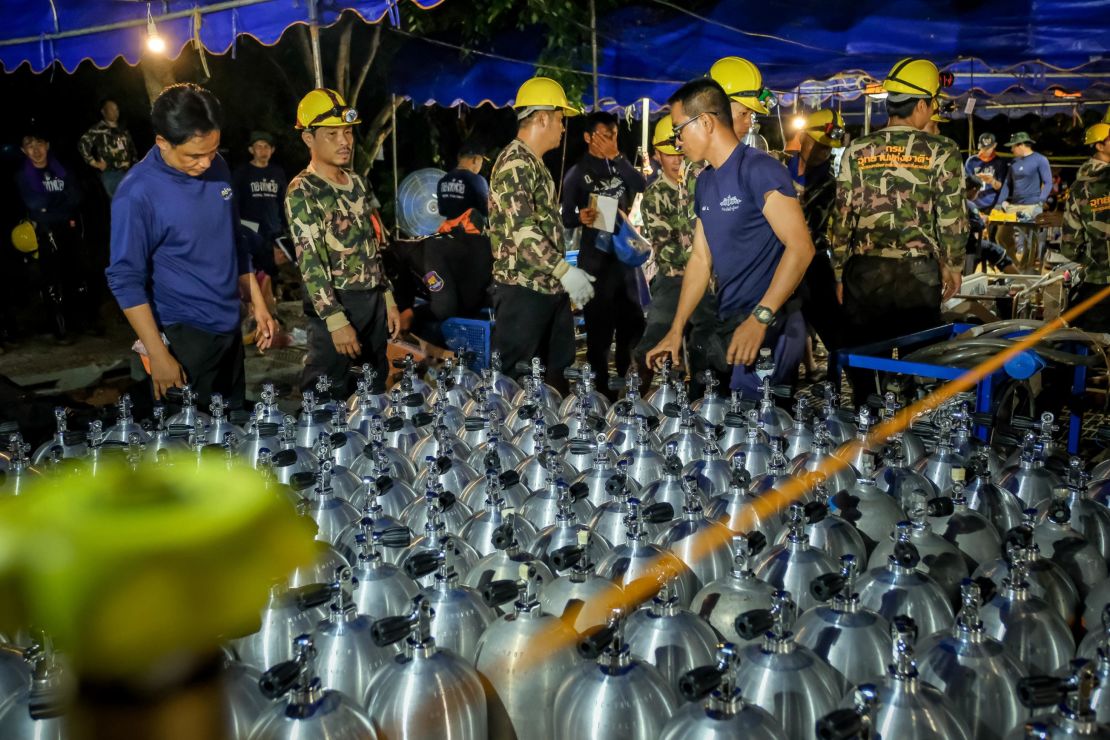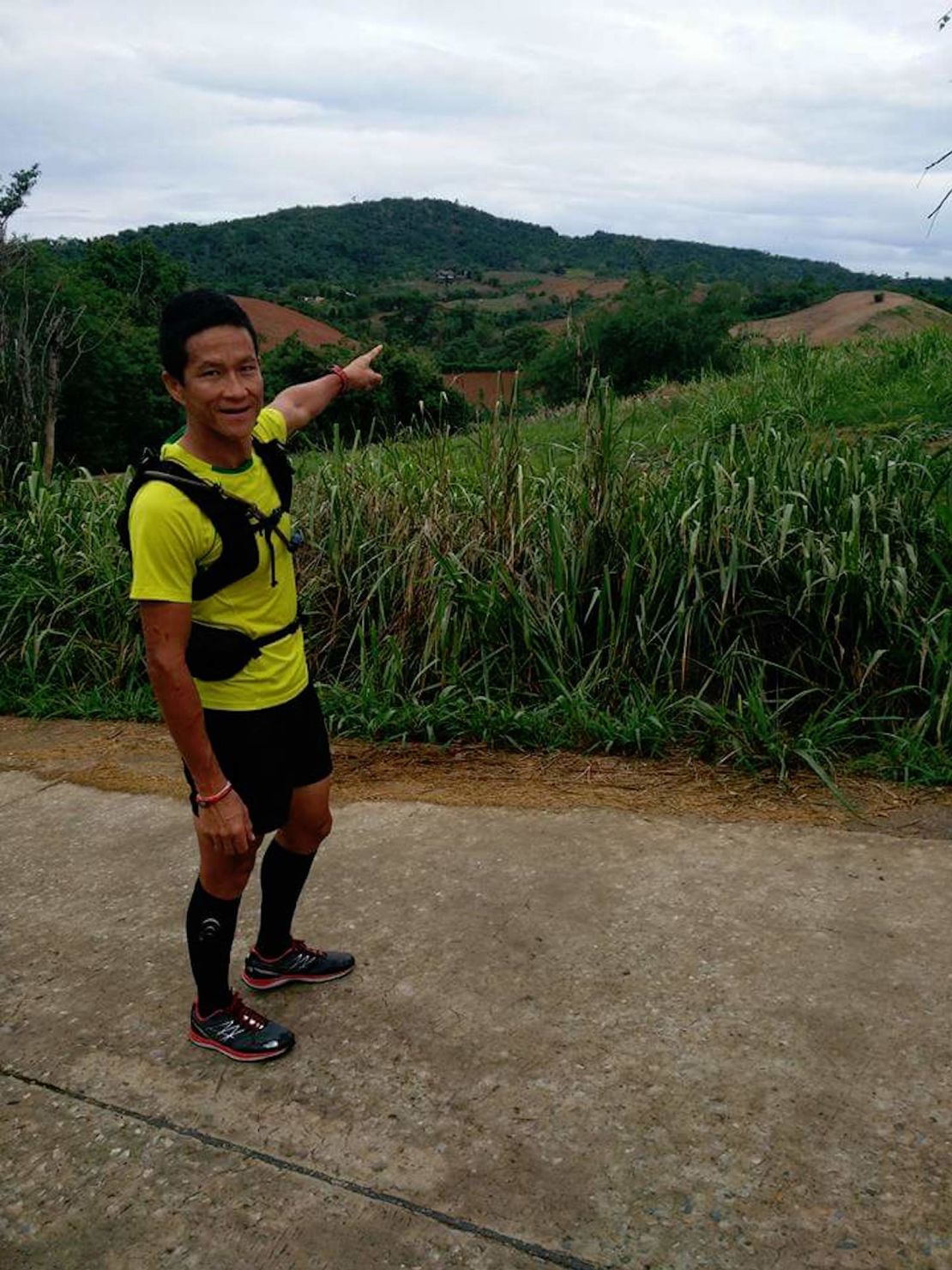Thai officials ruled out any immediate attempts to evacuate 12 football players and their coach trapped deep inside a system of caves in northern Thailand on Saturday despite concerns over low oxygen levels underground and poor weather forecasts.
“No, not today,” Narongsak Osottanakorn, the governor of Chiang Rai province, said after being pressed by reporters on rescue efforts.
Officials are considering a rescue plan involving a “buddy dive” – where an experienced adult diver would swim with each boy – to evacuate the team members, according to a US official familiar with the joint rescue operation.
Thai divers would lead the mission and US divers would preposition oxygen tanks, the US official said. The rescue team also includes divers and workers from Australia, the United Kingdom, and other parts of Europe and Asia.
Thai military officials have been briefed, the source said, and the country’s Prime Minister Prayut Chan-o-cha was to be told about the plan Saturday morning.
The rescue mission could begin as soon as the weekend, but no decision has been made whether to proceed, the US official said.
Low oxygen levels
On Friday, Thai Navy SEAL chief Rear Adm. Aphakorn Yoo-kongkaew said oxygen levels in the cave had dropped to 15%, a level that one Thai medic said posed a serious risk of hypoxia, the same condition that causes altitude sickness.
Gov. Osottanakorn said “air is a major issue,” but added that UK experts had confirmed the conditions in the chamber where the children are located were “all right.”
“The kids are still are able to walk around, play around comfortably,” he said. “If (there is) heavy rain and the situation is not good, we will try.”
Some of the children’s parents have sent letters but the governor said he was was not sure if the trapped boys had read them.
Authorities had originally suggested the safest strategy for the stricken team, aged 11 to 16, and their 25-year-old coach, would be to keep them in the Tham Luang Nang Non cave complex until the monsoon season had passed in October and water levels had subsided enough for them to walk out.
More heavy rain is expected to fall over the weekend but the governor emphasized that rescuers would only try to free the team if the risk to their lives was minimal.
“We are afraid of the weather and the (lack of) oxygen in the cave but we have to try to set the plan and find which plan is the best.”
Related: What are the options for rescuing trapped team?
Another possible rescue game plan
One recovery strategy the rescuers have been pursuing includes fitting the group with full-face oxygen masks and accompanying them on a long, dangerous swim through the narrow, pitch-black tunnels. Osottanakorn said the group were already “learning to dive” but that they were not yet ready.
It takes even the most experienced divers up to five hours to swim through jagged, narrow channels from where the boys are to safety outside. The UK divers who first reached the boys described their dive as “gnarly” and full of tight passages submerged in low-visability water.

Rescue teams above ground have drilled more than 100 holes in a bid to find a route to the trapped Thai cave boys, Osottanakorn said, but “it doesn’t look promising.”
The US official said a plan to route oxygen into the chamber where the boys are was also called off due to challenge of routing cable through cave system.
Rescuers under pressure
The death of an experienced rescue diver in the cave system underlined the inherent risks in attempting to move the boys.
Former Sgt. Saman Kunan, a Thai ex-SEAL, died at 2 a.m. Friday (2 p.m. Thursday ET), as he returned from an operation to deliver oxygen tanks to the cave where the boys are located. The 38-year-old ran out of air while underwater, an official said.
A military aircraft carried Kunan’s body from Chiang Rai to Satthahip Navy Base, where a funeral service was scheduled to take place, before a second in his home town in the province of Roi Et, northern Thailand.

Finnish volunteer diver Mikko Paasi, a long-term resident of Thailand, said Kunan’s death had changed the mood on the ground and made real for rescuers just how dangerous the mission had become.
“Definitely, you can feel it that it has an effect, but we’re moving on. Everyone is a professional so we’re trying to put it away and avoid it happening again,” he said, adding: “Everybody is focusing on getting these boys out – keeping them alive or getting them out.”
One of Kunan’s longtime friends, Sgt. Anuram Kaewchano, told CNN he was shocked to learn the news.
“I can’t believe this happened,” he told CNN by phone. “He was very fit, he exercised every day, and he was a triathlete. Our last trip together was to Malaysia.”
He said that the last time the two spoke, “we talked about the kids – whether they were out yet.”
The huge operation to rescue the group involves scores of Thai Navy SEALs, in addition to experts and volunteer divers from parts of Europe and Asia, as well as Australia and the US.
Billionaire inventor and entrepreneur Elon Musk said engineers from his SpaceX & Boring Co. were headed to Thailand to see if they could help.
International operation
The members of the Wild Boar soccer team were reported missing two weeks ago after they didn’t return from an outing after soccer practice. They entered the cave during fine weather but became trapped when a sudden downpour flooded the narrow tunnels.
The 12 boys and their coach were found deep inside the cave by two British cave divers on Monday, perched on a rock slab above floodwaters, after nine days without food or fresh water.

Rescue teams have been pumping millions of liters of water from the cave in an attempt drain the cave but the impending weekend rains threaten to undermine the work.
Related: Satellite images show rain forecast in Chiang Rai
Thailand’s monsoon season runs from July to October and, while the past few days have been relatively dry, the long term forecast is rain for months.
CNN’s Kocha Olarn reported from Chiang Rai, Euan McKirdy reported from Hong Kong while Lauren Said-Moorhouse reported from London. CNN’s David McKenzie, Rebecca Wright, Ryan Browne, Karla Cripps and Jo Shelley, and interns Pia Deshpande and Jessie Yeung contributed to this report.
























